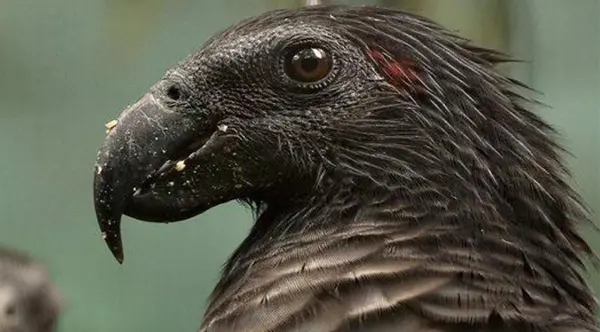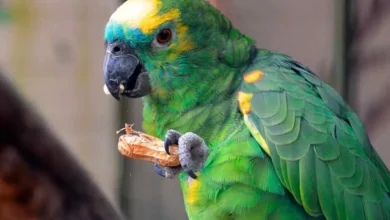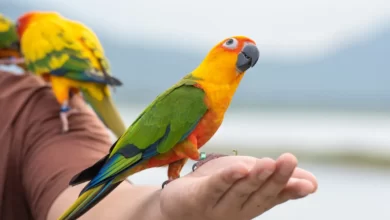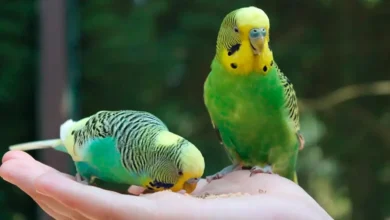The Enigmatic Dracula Parrot: Nature’s Gothic Wonder
Nestled in the dense, misty forests of New Guinea, an avian marvel roams the canopy – the Dracula Parrot. Known scientifically as Psittrichas fulgidus and colloquially referred to as the vulture parrot or aquiline parrot, this bird embodies a unique blend of elegance and eerie charm. This blog delves into the fascinating world of the Dracula Parrot, exploring its distinctive features, habitat, behavior, and conservation status.
Introduction to the Dracula Parrot

The Dracula Parrot, with its striking appearance and peculiar habits, has captivated the interest of ornithologists and bird enthusiasts alike. This parrot stands out not only for its gothic moniker but also for its unique ecological niche and behavior that sets it apart from its avian relatives.
Appearance
| Characteristic | Description |
|---|---|
| Total length | Approximately 46 cm (18 in) |
| Weight | 680–800 g (24–28 oz) |
| Plumage | Predominantly black, with greyish scaling on the chest |
| Red belly, uppertail coverts, and wing-panels | |
| Male features | Red spot behind the eye (absent in females) |
Diet and Adaptations
| Adaptation | Description |
|---|---|
| Highly specialized | Feeds almost exclusively on a few species of figs |
| Bare facial skin | Adaptation to avoid feather-matting from sticky fruits |
| Vulture-like profile | Long hooked bill and relatively small head, resembling a vulture |
Conservation Status
- Vulnerable on the IUCN Red List due to overhunting (feathers are prized) and habitat loss.
- Listed on Appendix II of CITES.
Appearance and Physical Characteristics

The Dracula Parrot is a sight to behold, boasting a combination of deep, glossy black feathers and vibrant red plumage. This stark contrast gives the bird its dramatic and somewhat sinister appearance, akin to the dark, mysterious characters in Gothic literature. The head is predominantly black with a bare, grayish face, reminiscent of a vulture, hence the name vulture parrot. This bare facial skin helps to keep the bird clean when feeding on fruits, preventing feathers from becoming matted with sticky fruit juices.
Measuring about 46 cm (18 inches) in length and weighing between 680 to 800 grams (1.5 to 1.8 pounds), the Dracula Parrot is relatively large compared to other parrots. Its beak is strong and hooked, well-adapted for tearing into tough fruits, which are a staple in its diet. The wing feathers are also notably long and pointed, facilitating swift and agile flight through the dense rainforest canopy.
Habitat and Distribution
The Dracula Parrot is endemic to the rainforests of New Guinea, inhabiting both the island’s primary lowland and montane forests. These birds prefer altitudes ranging from 600 to 1,200 meters but can occasionally be found at higher elevations. Their habitat is characterized by high humidity, dense foliage, and a plethora of fruit-bearing trees, providing an ideal environment for their frugivorous lifestyle.
New Guinea’s unique geographical and ecological conditions have played a crucial role in the evolution and adaptation of the Dracula Parrot. The island’s isolation and diverse habitats have allowed a wide variety of species to thrive, each occupying specific ecological niches.
Behavior and Ecology
Understanding the behavior and ecological role of the Dracula Parrot provides insight into its survival strategies and interactions with its environment. These birds exhibit several unique behaviors that distinguish them from other parrot species.
Feeding Habits
Primarily frugivorous, the Dracula Parrot feeds on a variety of fruits, nuts, and seeds found in the rainforest canopy. They have a particular preference for figs, which are abundant in their habitat. Their strong beaks allow them to break open hard shells and tough-skinned fruits with ease. Interestingly, unlike many other parrots, Dracula Parrots rarely consume leaves, flowers, or insects.
The feeding habits of the Dracula Parrot play a significant role in seed dispersal within the forest ecosystem. By consuming fruits and excreting the seeds at different locations, they contribute to the regeneration and spread of various plant species, maintaining the health and diversity of the rainforest.
Social Structure and Reproduction
Dracula Parrots are typically observed in pairs or small family groups, exhibiting strong social bonds. They are known for their monogamous breeding behavior, with pairs often remaining together for life. During the breeding season, which generally occurs between March and July, these birds engage in elaborate courtship displays. Males perform aerial acrobatics and vocalizations to attract females, showcasing their agility and strength.
Nesting usually takes place in tree cavities, which provide protection from predators and harsh weather conditions. The female lays a clutch of two to three eggs, which she incubates for about 28 days. Both parents participate in feeding and caring for the chicks until they fledge, ensuring the young birds have the best start in life.
Vocalizations and Communication
The Dracula Parrot’s vocal repertoire is as unique as its appearance. These birds communicate through a variety of calls, including harsh squawks, melodic whistles, and mimicry of other bird species. Their vocalizations serve multiple purposes, from marking territory and signaling alarm to facilitating bonding between mates and family members.
Conservation Status and Threats
Despite its striking appearance and ecological significance, the Dracula Parrot faces several threats that jeopardize its survival. Understanding these challenges is crucial for developing effective conservation strategies to protect this remarkable species.
Habitat Loss and Degradation
The primary threat to the Dracula Parrot is habitat loss due to deforestation and land conversion for agriculture and logging. As rainforests are cleared or degraded, the availability of food sources and nesting sites diminishes, directly impacting the parrot’s ability to survive and reproduce.
Hunting and Trade
In addition to habitat loss, the Dracula Parrot is also at risk from hunting and illegal trade. Its striking appearance makes it a target for poachers who capture these birds for the exotic pet trade. Although international trade is regulated under the Convention on International Trade in Endangered Species of Wild Fauna and Flora (CITES), illegal activities persist, posing a significant threat to wild populations.
Climate Change
Climate change poses an emerging threat to the Dracula Parrot, as shifts in temperature and precipitation patterns can alter the distribution and availability of food resources. Changes in forest composition and structure due to climate change may also affect nesting sites and increase the vulnerability of these birds to extreme weather events.
Conservation Efforts and Future Outlook
Conservation efforts for the Dracula Parrot focus on habitat protection, enforcement of hunting regulations, and community engagement. Several initiatives are underway to safeguard the future of this enigmatic bird.
Protected Areas and Habitat Restoration
Establishing protected areas and promoting habitat restoration are critical components of conservation strategies for the Dracula Parrot. These measures help to preserve the integrity of rainforest ecosystems and ensure the availability of essential resources for the parrot’s survival.
Community-Based Conservation
Engaging local communities in conservation efforts is vital for the success of these initiatives. By involving indigenous and local populations in monitoring and protecting parrot habitats, conservationists can foster a sense of stewardship and ensure sustainable practices that benefit both the parrots and the people who share their environment.
Research and Monitoring
Ongoing research and monitoring are essential for understanding the population dynamics and ecological requirements of the Dracula Parrot. Data collected from field studies can inform conservation strategies and help identify priority areas for protection and management.
Education and Awareness

Raising awareness about the Dracula Parrot and its plight is crucial for garnering support for conservation efforts. Educational programs and media campaigns can highlight the importance of preserving this unique species and the rainforest ecosystems they inhabit.
The Dracula Parrot, with its gothic beauty and ecological significance, represents a fascinating chapter in the story of New Guinea’s biodiversity. Protecting this enigmatic bird requires concerted efforts to address the threats it faces and ensure the preservation of its rainforest habitat. Through a combination of habitat protection, community engagement, and research, we can work towards a future where the Dracula Parrot continues to thrive in the misty forests of New Guinea, a living symbol of nature’s gothic wonder.
The Dracula Parrot in Culture and Symbolism
The Dracula Parrot’s striking appearance and mysterious aura have not only captured the interest of scientists but also inspired various cultural interpretations and symbolic associations. In this section, we explore how this unique bird features in the folklore and symbolism of the regions it inhabits.
Indigenous Beliefs and Folklore
Among the indigenous tribes of New Guinea, the Dracula Parrot holds a special place in local folklore. Its dramatic plumage and unique vocalizations have led to numerous myths and legends that portray the bird as a mystical creature. Some tribes believe that the parrot possesses spiritual powers, serving as a messenger between the physical world and the spirit realm. Its calls are thought to be omens or messages from ancestors, guiding the living in their daily lives.
Symbolism in Modern Culture
In contemporary culture, the Dracula Parrot has come to symbolize the enigmatic and the exotic. Its gothic appearance has made it a popular subject in art and literature, often depicted as a symbol of mystery and otherworldliness. The bird’s striking colors and unusual features have also made it a favorite among wildlife photographers and artists, who seek to capture its beauty and enigmatic charm.
The Dracula Parrot as an Ambassador for Conservation
Given its unique appearance and the growing interest in its conservation, the Dracula Parrot has also become an ambassador for the protection of New Guinea’s rainforests. Conservation organizations use the bird’s image to raise awareness about the importance of preserving biodiversity and protecting endangered species. Its striking look makes it an effective symbol for environmental campaigns, drawing attention to the broader issues of habitat destruction and climate change.
Scientific Significance of the Dracula Parrot
Beyond its cultural and symbolic significance, the Dracula Parrot is also of great scientific interest. Researchers study this bird to gain insights into various aspects of avian biology, ecology, and evolution.
Evolutionary Adaptations
The Dracula Parrot’s unique physical and behavioral traits provide valuable information about evolutionary adaptations. Its vulture-like appearance, particularly the bare facial skin, is an adaptation that minimizes the mess associated with feeding on sticky fruits. This trait, combined with its specialized diet, offers insights into how different species evolve to exploit specific ecological niches.
Genetic Studies
Genetic studies of the Dracula Parrot can help scientists understand the evolutionary relationships between different parrot species. By analyzing the parrot’s DNA, researchers can trace its lineage and explore how it has adapted to its environment over time. These studies also contribute to broader efforts to conserve genetic diversity within avian populations, which is crucial for their long-term survival.
Ecological Role
As a frugivore and seed
disperser, the Dracula Parrot plays a crucial role in maintaining the health and diversity of rainforest ecosystems. Studying its feeding habits and movement patterns helps ecologists understand the complex interactions between species and their environment. This knowledge is essential for developing effective conservation strategies that protect not only the parrot but also the broader ecosystem.
The Future of the Dracula Parrot
The future of the Dracula Parrot hinges on our ability to address the threats it faces and implement effective conservation measures. As we look ahead, several key actions can help ensure the survival of this remarkable species.
Strengthening Legal Protections
Strengthening legal protections for the Dracula Parrot and its habitat is crucial. This includes enforcing existing laws that prohibit illegal logging and hunting, as well as implementing new regulations that address emerging threats such as climate change. International cooperation is also essential, as New Guinea’s rainforests span multiple countries and require coordinated conservation efforts.
Promoting Sustainable Development
Promoting sustainable development practices in New Guinea is vital for balancing the needs of local communities with the conservation of biodiversity. This includes supporting eco-friendly agriculture, sustainable logging practices, and ecotourism initiatives that provide economic benefits while preserving natural habitats. By creating alternative livelihoods that do not rely on habitat destruction, we can reduce the pressure on the Dracula Parrot’s environment.
Enhancing Conservation Funding
Securing adequate funding for conservation efforts is essential for the long-term protection of the Dracula Parrot. This includes funding for protected areas, research programs, community engagement initiatives, and enforcement of conservation laws. Increased financial support from governments, non-governmental organizations, and private donors can help ensure that conservation programs have the resources they need to succeed.
Fostering Global Awareness and Support
Finally, fostering global awareness and support for the Dracula Parrot and its conservation is crucial. This can be achieved through educational programs, media campaigns, and partnerships with international conservation organizations. By raising the profile of the Dracula Parrot and highlighting its ecological and cultural significance, we can inspire a global movement to protect this enigmatic bird and its rainforest home.
Conclusion
The Dracula Parrot is a testament to the wonders of nature, combining gothic beauty with ecological importance. As we have explored in this blog, this remarkable bird faces significant challenges that threaten its survival.
However, through concerted conservation efforts, community engagement, and global awareness, we can work towards a future where the Dracula Parrot continues to enchant and inspire us. By protecting the Dracula Parrot, we are also preserving the rich biodiversity of New Guinea’s rainforests, ensuring that these vital ecosystems remain vibrant and thriving for generations to come.





